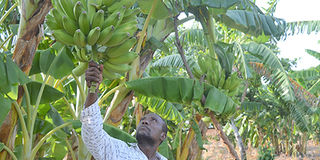Wonder pits offer plenty of harvest in arid lands

Bakari Omar in his farm in Sagalato village in Lunga Lunga, Kwale county. He is among farmers in the area who use zai pits for their farms' crop cultivation. PHOTO | SAMUEL BAYA | NMG
What you need to know:
- The semi-arid area receives very little or no rainfall at all, with this year so far being of the worst periods.
- Masemo explains that the zai pit is first filled up with some dry sticks to a height of about 1cm, followed by another 15cm of dry grass.
- The top soil, mixed with manure, is then filled to a height of 20cm, then some green grass and ash topped up before the seedlings are planted.
- He also keeps 20 cows and 50 goats to diversify his agribusiness. Some 500 metres away, Omar’s farm also hosts a lush green banana crop of Kisukari and Bokoboko varieties.
One hardly notices any traces of green vegetation as they traverse the dry Sagalato village in Lunga Lunga, Kwale county.
The semi-arid area receives very little or no rainfall at all, with this year so far being of the worst periods.
But some 3km from Lunga Lunga trading centre, one comes across a marvel of lush green farms. Ali Hamisi Masemo, 50, and Bakari Omar, 42, who are neighbours, are behind the farms that host bananas and cassava, among other crops.
Masemo went into farming in 2016 mainly for sustenance, before turning commercial.
“My neighbour began growing bananas and I was perplexed by the level of knowledge he had to grow the crop in a dry area like Lunga Lunga. More so, he was doing well without irrigation,” Masemo says.
He approached the farmer for advice, and borrowed what the neighbour was doing, which was using zai pits. The pits normally measure an average of 2 by 2 metres, and are 150cm deep.
They are filled with crop residue, manure or fertiliser and crops planted inside. Masemo bought 100 banana seedlings from the neighbour at Sh5,000. Today, his farm is teeming with a variety of bananas that include Giant Cavendish.
“I planted the latest stems in late 2017 and started harvesting last year. Customers visit here to buy fresh bananas at Sh250 a bunch,” he says.
Masemo explains that the zai pit is first filled up with some dry sticks to a height of about 1cm, followed by another 15cm of dry grass.
PREPARED TWO MONTHS BEFORE ACTUAL PLANTING
The top soil, mixed with manure, is then filled to a height of 20cm, then some green grass and ash topped up before the seedlings are planted.
“The zai pits are prepared one to two months before the time of actual planting,” he says.
Away from the banana farm, he also grows cassava. On average, the farmer rakes in at least Sh30,000 from both bananas and cassavas a month, with the venture guaranteeing his family regular income.
He also keeps 20 cows and 50 goats to diversify his agribusiness. Some 500 metres away, Omar’s farm also hosts a lush green banana crop of Kisukari and Bokoboko varieties.
“Initially, I was a hawker and would get Sh80 a day but from farming I now make up to Sh1,200 daily,” says Omar, who farms on two acres. Some of the banana diseases the two grapple with are anthracnose, black sigatoka and fusarium wilt.
Baha Nguma, a food Security and dryland farming consultant at the Coast, says sustainable land use in the drylands can only be achieved through the use of conservation agriculture, particularly the application of zai pit technology.
“This is a rainwater harvesting technology employed by smallholder farmers with the principal aim of harvesting, conserving water and restoring soil fertility to end up with good harvest,” he says.






